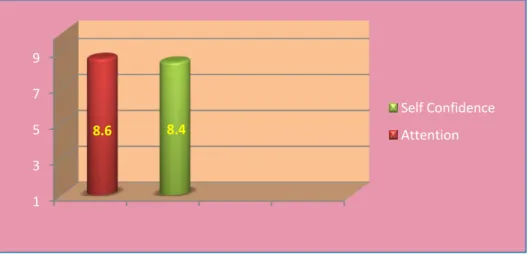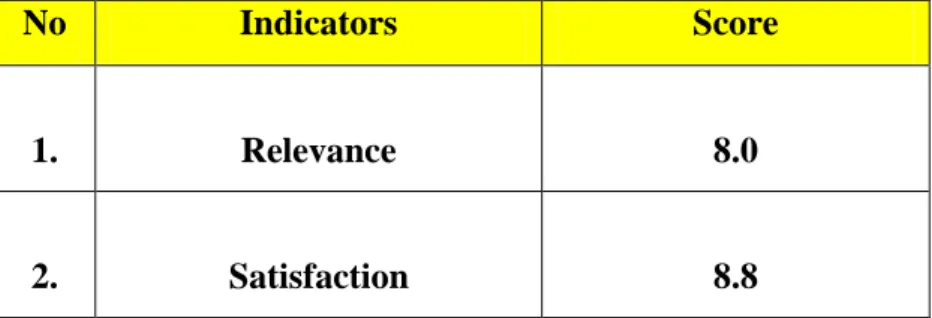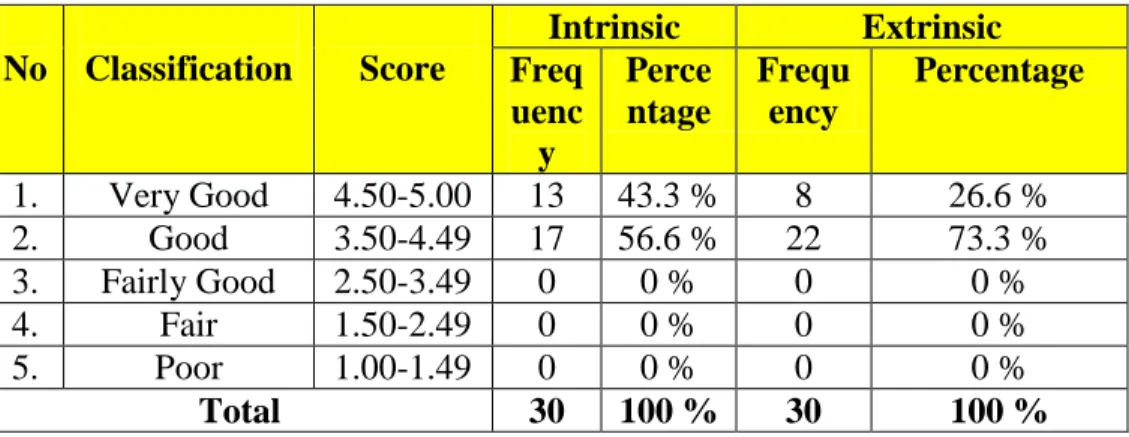Analysis of students' motivation while speaking using a pictorial riddle approach (an experimental study on the X-1 class students of SMA Negeri 8 Mandai). The result of the research findings indicates that the students' motivation in speaking is obtained through the application of the Pictorial Riddle Approach, which relates to intrinsic and extrinsic motivation. The score means that the students' intrinsic motivation is higher than the students' extrinsic motivation through the application of Pictorial Riddle Approach.
Based on the above explanation, the researcher conducted a research entitled “Analyzing the students' speaking motivation using a picture puzzle approach at SMA Negeri 8 Mandai”. What is students' intrinsic motivation in speaking using picture puzzle approach in tenth grade students of SMA Negeri 8 Mandai. What is students' extrinsic motivation in speaking using picture puzzle approach in tenth grade students of SMA Negeri 8 Mandai.
The intrinsic motivation of the students in speaking through the use of the pictorial riddle approach in the tenth grade of SMA Negeri 8 Mandai. The students' extrinsic motivation in speaking through the use of the Pictorial Riddle Approach in the tenth grade students of SMA Negeri 8 Mandai.
INTRODUCTION
- Problem Statement
- Objective of the Study
- Significance of the Study
- Scope of the Study
The test was used to find out the students' intrinsic and extrinsic motivation when speaking through the pictorial riddle approach. The table above shows the scores of the students on the test in terms of intrinsic motivation and extrinsic motivation. The application of the Pictorial Riddle Approach could analyze the students' motivation when talking about intrinsic and extrinsic motivation.
This case indicates that the relevance of students' extrinsic motivation is lower than students' satisfaction in speaking with the pictorial puzzle approach. The researcher might say that through the Pictorial Riddle Approach was a good way to analyze the students' motivation in speaking. Students' intrinsic motivation in speaking through the use of Pictorial Riddle Approach shows 9.46 as score.
The extrinsic motivation of the students when speaking through the application of the Pictorial Riddle Approach shows a score of 8.18. The application of the Pictorial Riddle Approach indicates that the students' intrinsic motivation (9.46) is higher than the students' extrinsic motivation (8.18) when speaking.
REVIEW OF RELATED LITERATURE
Definition of Pictorial Riddle Approach
Stages in learning process models with Pictorial Riddle study conducted in accordance with the study model of stages of learning, but there are modifications in the presentation of the problem raised by the Pictorial Riddle method (James in Peter, 1977:10). Pictorial Riddle can be used to introduce a topic, news or concept; exchange for the production of creative production; convey information on a particular subject;. The most important thing in the successful use of Pictorial Riddle is the nature of the teacher's questions.
Most questions to be used with the Pictorial Riddle should be open to divergent because such questions allow for many "correct" answers. According to Barman, the Pictorial Riddle Approach shows a visual problem via a drawing on a 35mm page, poster or an overhead transparency. It can be an excellent tool to encourage student discussion and involvement in science investigations.
Procedure of Pictorial Riddle Approach
Assign students tasks to answer questions whose answers can be found in the learning process experienced by the students. Students are given the opportunity by the teacher for discussion in small groups to seek answers to the questions that have been proposed before. Teachers line up students' answers and answer questions that students cannot answer or students who are still confused.
Students are expected to summarize the conclusions in the form of the formulation as a result of what has been learned that can be accounted for.
Advantages and Disadvantages of Pictorial Riddle Approach
Concept of Motivation
- Definition of Motivation
- Types of Motivation
- Element of Motivation
- Characteristics of Students‟ Motivation
- Model of Motivation Design
The same goes for Cherry (2012:1). Motivation is defined as the process that initiates, guides and sustains goal-directed behavior. In another definition, motivation is a very important factor that determines the success or failure in learning a second language, because motivation can have a direct influence on the frequency of using learning strategies, the willpower of learning, the setting of goals and the persistence of learning (Qin in Lie and Pan, 2009:123). Motivation is a kind of mind or mental force that cannot identify with senses; it is quite difficult to measure.
Aderson et al in Rahmawati (2012:11) say that motivation is a concept or variable without physical reality. Intrinsic motivation is a response to needs that exist within the learner, such as curiosity, the need to know and feelings of competence or growth (Eggen and Kauchak. In contrast, extrinsic motivation is an external force in the form of expectation, praise and reward power students in English learning.
When students work hard to win the favor of their parents, win the praise of teachers or earn rewards such as pocket money, we can rightly conclude that their motivation is primarily extrinsic, that their reasons for working and studying in the are primarily outside themselves and that the purpose of learning is outside themselves. is not about the knowledge itself, but about the outer rewards of acquiring self-esteem. In short, it is strongly believed that the experience of success goes hand in hand with the feeling of accomplishment.
Concept of Speaking
In addition, Thornburry argues that speaking activity in the classroom should increase students' awareness, which consists of three parts: attention that requires the students to pay attention, noticing more than just paying attention, having the students consciously register the occurrence of a certain event and/or entity, and understand where students can identify a general rule, principle, or pattern. As we know language as a tool for daily communication is one of the productive skills of English, which means oral communication in which the speaker expresses ideas, information or feelings to others. Accuracy is the state of being correct or exact and without error, especially as a result of careful purchasing.
According to Gardner, vocabulary has some meaning, namely vocabulary is to interpret the reader of a book in a foreign language with the English equivalent of the words used in it, accept that all are unclear, and also has the meaning of the whole stock of words in use. by any set of persons, or by an individual. In other words, the language learner must be able to say what he or she wants to say. It must be learned because the variable transmission in speech thought the understanding of structural patterns.
Belief is a mental process that makes one strong enough to do or take action (Klippel and Friederike, 1987: 87). The level of confidence each of us has is relative to how much we believe in ourselves. If we lack confidence or our level of self-confidence is low (or, even worse, if we have no confidence at all), we can start building self-confidence when we make an active commitment to do it (Wilhelm Smoothness.
It means speaking English non-literally and reducing forms means using English with contractions, elisions and vowel reduction. According to David in Hasriati, oral communication is a two-way process between the speaker and the listener and includes the productive ability of speaking and the receptive ability of understanding. Ur explains some characteristics of successful speaking activities, which include students talking a lot, the participant is equal, motivation is high and the language is of an acceptable level.
As much of the time allocated to the activity is actually taken up by the students speaking. This means that all students have a chance to speak and that contributions are fairly evenly distributed. Students express themselves with utterances that are appropriate, easy to understand for teaching others and have an acceptable level of linguistic accuracy.
Conceptual Framework
The conceptual framework above shows the research process in analyzing the students' motivation in speaking through the application of the Pictorial Riddle Approach. The aim of this research is to find out the motivation of students, in which the intrinsic motivation of students and the extrinsic motivation of students are central.
RESEARCH METHOD
Research Variables and Indicators
The implementation of the Pictorial Riddle Approach was the approach the teacher used to teach the students to motivate the students to speak. The indicator for this research measured students' intrinsic motivation in speaking, which deals with attention and confidence, and extrinsic motivation in speaking, which deals with relevance and satisfaction.
Population and Sample
The test was conducted by giving the questionnaire to see the students' intrinsic and extrinsic motivation to speak after the treatment. The data in the above table show the students' internal motivation in speaking, the indicators of which are attention and self-confidence, as a result of the calculation of the students' test through the Riddles Pictorial Approach, where the results of students' attention (8.6) and the results of students' self-confidence (8.4). Students' internal motivation, whose indicators are attention and self-confidence, show that the result of students' attention (8.6) is great and i.
This example shows that the students' attention score for intrinsic motivation (8.6) is higher than the students' self-esteem score (8.4). In relation to the data above, the picture puzzle approach makes students' attention higher than students' speaking confidence. The students' external motivation, whose indicators are satisfaction and relevance, show that the students' satisfaction score (8.0) is lower and that of the students.
The relevance score of the students is obtained from the total score of each answer that the students choose in the questionnaire (8.0) and so with. This example shows that the student's intrinsic motivation adequacy score (8.0) is lower than the student's satisfaction score (8.8). In conjunction with the above data, the picture puzzle approach makes the student's satisfaction higher than the student's speaking adequacy.
In this part, discussion concerns the interpretation of findings arising from the result of findings on the students' motivation to speak. The researcher concludes that the students' score of intrinsic motivation in speaking is 9.46 and the students' score of extrinsic motivation in speaking is 8.18. As stated in the previous chapter, the current research investigated the students' motivation in intrinsic motivation and extrinsic motivation in speaking through the application Pictorial Riddle Approach.
To make the class more active, the teacher should use popular pictures, as they can motivate students to speak.




